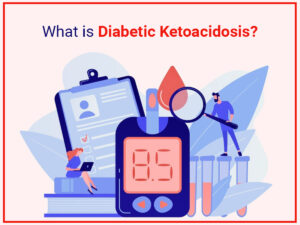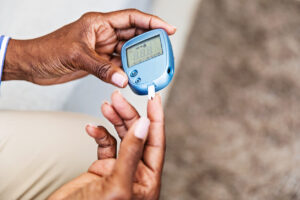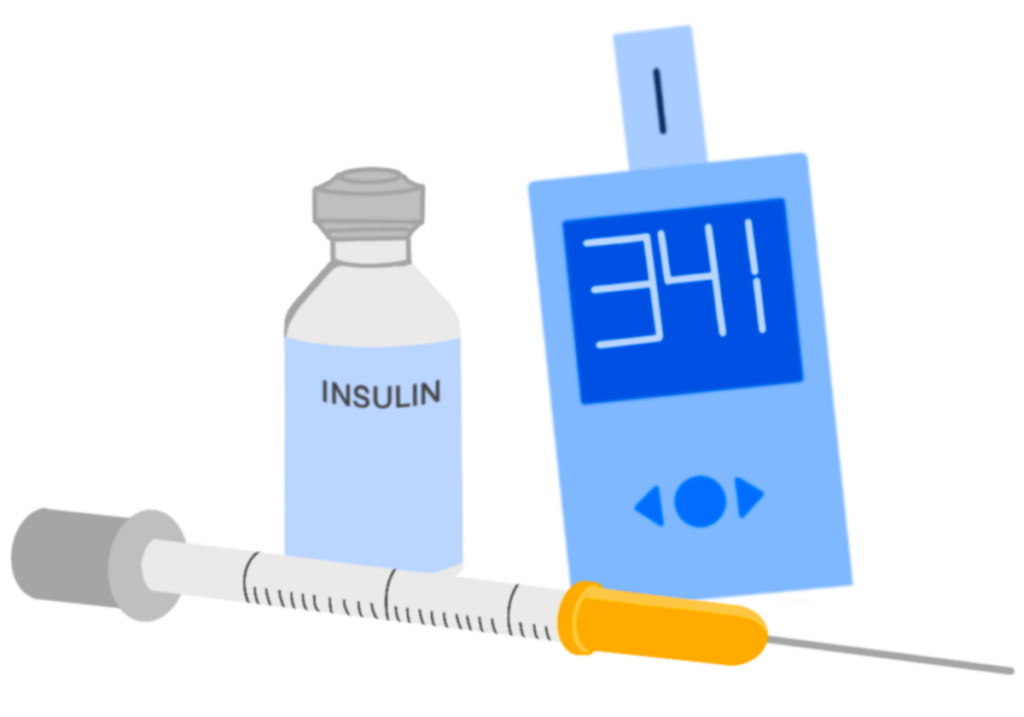Treatment of Diabetic Ketoacidosis Coma: Diabetic ketoacidosis (DKA) is a severe complication of diabetes mellitus, characterized by hyperglycemia, ketosis, and metabolic acidosis. When left untreated or improperly managed, DKA can progress to a coma, posing life-threatening risks to individuals with diabetes. This blog aims to delve into the intricate details of managing DKA coma, outlining the essential steps, medications, and interventions necessary for effective treatment.
Contents
What is Diabetic Ketoacidosis Coma?

Diabetic ketoacidosis coma is a life-threatening complication that can occur in individuals with diabetes mellitus, typically when there is a severe lack of insulin in the body. Diabetic ketoacidosis (DKA) is a condition characterized by dangerously high levels of blood sugar (hyperglycemia), ketone production, and metabolic acidosis. When DKA progresses to its most severe stage, it can result in a coma, which is a state of unconsciousness where the affected individual is unresponsive to stimuli.
Mechanisms Leading to DKA Coma:
The development of diabetic ketoacidosis coma stems from the underlying metabolic disturbances associated with DKA:
- Insulin Deficiency: DKA often occurs in individuals with type 1 diabetes, where there is a profound deficiency of insulin due to the autoimmune destruction of pancreatic beta cells. In some cases, it can also occur in individuals with type 2 diabetes when insulin levels are significantly inadequate.
- Hyperglycemia: Insulin deficiency leads to impaired glucose uptake by cells, causing blood sugar levels to rise excessively. This hyperglycemia results in osmotic diuresis, leading to dehydration and electrolyte imbalances.
- Ketogenesis: In the absence of sufficient insulin to promote glucose utilization, the body begins breaking down fat stores for energy through a process called lipolysis. This breakdown of fats results in the production of ketone bodies (acetoacetate, beta-hydroxybutyrate, and acetone).
- Metabolic Acidosis: The accumulation of ketone bodies in the blood leads to a state of metabolic acidosis. Ketone bodies are acidic substances, and their increased concentration lowers blood pH, disrupting normal physiological functions.
Treatment Methods for Diabetic Ketoacidosis Coma
The treatment of diabetic ketoacidosis (DKA) coma is a complex and multi-faceted process aimed at correcting the underlying metabolic derangements while addressing associated complications. Prompt recognition and initiation of treatment are crucial to prevent serious complications and improve outcomes. Here’s an overview of the treatment methods for diabetic ketoacidosis coma:
Fluid Resuscitation
Diabetic ketoacidosis (DKA) often leads to significant dehydration due to osmotic diuresis and fluid loss through vomiting and polyuria. Fluid resuscitation is the cornerstone of DKA management to restore intravascular volume, improve tissue perfusion, and correct electrolyte imbalances.
Isotonic saline (0.9% NaCl) is the preferred fluid initially as it expands plasma volume without altering serum osmolality. Rapid administration of fluids is crucial, but it must be balanced with careful monitoring to avoid complications such as fluid overload, especially in patients with underlying cardiovascular or renal disease. The rate of fluid administration may be adjusted based on the severity of dehydration, hemodynamic status, and response to therapy, with close attention to vital signs and urine output.
Insulin Therapy

Insulin therapy is vital in reversing the underlying insulin deficiency and halting ketogenesis in DKA. Regular insulin, with its rapid onset of action, is typically administered intravenously to achieve quick normalization of blood glucose levels. Continuous intravenous insulin infusion is preferred over subcutaneous administration initially due to its ability to provide precise control and facilitate frequent adjustments based on glucose monitoring.
The goal of insulin therapy is to gradually reduce blood glucose levels while simultaneously suppressing lipolysis and ketone production. Careful monitoring of blood glucose levels, electrolytes, and ketones is essential to prevent hypoglycemia and ensure therapeutic efficacy. Once DKA resolves, patients can transition to subcutaneous insulin therapy with close monitoring and dose adjustments as needed to maintain glycemic control.
Electrolyte Replacement
Electrolyte imbalances, particularly hypokalemia and metabolic acidosis, are common in DKA and must be corrected cautiously to prevent complications such as cardiac arrhythmias and respiratory failure. Potassium replacement is crucial to replenish intracellular stores depleted by insulin therapy and reverse the shift of potassium into the extracellular space.
Serum potassium levels should be monitored closely, and replacement therapy adjusted based on the degree of hypokalemia and urinary output to avoid rapid fluctuations. Bicarbonate therapy may be considered in severe cases of metabolic acidosis to correct acidemia and improve hemodynamic stability. However, its routine use is controversial, and its administration should be guided by careful assessment of acid-base status and consideration of the risks and benefits.
Monitoring and Correction of Complications
Continuous monitoring of various parameters, including blood glucose, electrolytes, ketones, arterial blood gases, and vital signs, is essential throughout the management of DKA to guide treatment adjustments and identify complications promptly. Hypoglycemia must be avoided by closely monitoring blood glucose levels and adjusting insulin therapy and carbohydrate intake accordingly.
Electrolyte disturbances should be corrected promptly, with particular attention to potassium and bicarbonate levels to prevent cardiac arrhythmias and maintain acid-base balance. Complications such as cerebral edema, a rare but potentially life-threatening complication of DKA treatment, must be promptly recognized and managed with appropriate interventions, including hypertonic saline therapy and close neurological monitoring.
Identification and Treatment of Precipitating Factors
Identifying and addressing the underlying causes or precipitating factors contributing to DKA is essential to prevent recurrence and improve long-term outcomes. Common precipitating factors include infection, non-compliance with insulin therapy, trauma, surgery, and concomitant medical conditions such as pancreatitis or myocardial infarction.
Prompt recognition and treatment of underlying infections with appropriate antibiotics are crucial, along with supportive measures to alleviate physiological stressors and minimize insulin resistance. Patient education and counseling regarding diabetes management, adherence to insulin therapy, and recognition of early warning signs of DKA recurrence are essential to empower patients to take an active role in their care and reduce the risk of future episodes.
Neurological Monitoring and Management
Neurological monitoring is critical in DKA management to assess the patient’s level of consciousness, detect signs of cerebral edema, and prevent neurological complications.
- Serial neurological assessments, including evaluation of mental status, pupillary response, and reflexes, should be performed regularly to detect early signs of neurological deterioration.
- Cerebral edema, although rare, can occur during DKA treatment, particularly in pediatric patients, and may manifest with symptoms such as headache, altered mental status, and neurological deficits.
Prompt recognition of cerebral edema is essential, and management may involve interventions such as head elevation, hypertonic saline therapy, and mannitol administration under close neurological monitoring to reduce intracranial pressure and prevent further neurological compromise.
Transition to Subcutaneous Insulin Therapy
Once the acute metabolic derangements of DKA are corrected, and the patient’s condition stabilizes, a transition to subcutaneous insulin therapy is initiated for long-term glycemic control.
Subcutaneous insulin therapy typically involves a combination of basal and prandial insulin to mimic physiological insulin secretion. Close monitoring of blood glucose levels and adjustment of insulin doses are necessary during the transition period to prevent the recurrence of DKA and achieve optimal glycemic control.
Patient education regarding insulin administration, self-monitoring of blood glucose, recognition of hyperglycemia and hypoglycemia symptoms, adherence to lifestyle modifications, and regular follow-up appointments are essential components of long-term diabetes management.
Patient Education and Follow-up

- Patient education is crucial in DKA management to empower individuals with diabetes to recognize early warning signs, adhere to insulin therapy and dietary recommendations, and prevent future episodes of DKA.
- Education topics may include proper insulin administration techniques, self-monitoring of blood glucose, recognition of symptoms indicating the need for medical attention, and strategies to optimize glycemic control and prevent complications.
- Regular follow-up appointments with healthcare providers are essential for ongoing monitoring, adjustment of treatment regimens, and evaluation of glycemic control and metabolic parameters.
Engaging patients in shared decision-making and promoting self-management skills can improve treatment adherence, enhance patient satisfaction, and ultimately lead to better long-term outcomes in diabetes management.
Which Diabetic Ketoacidosis Coma Treatment Method To Choose?
Choosing the appropriate treatment method for diabetic ketoacidosis (DKA) coma requires careful consideration of various factors to ensure optimal outcomes. Several factors influence the selection of treatment modalities, including:
- Severity of DKA: The severity of DKA, as reflected by parameters such as blood glucose levels, pH, bicarbonate levels, and degree of ketonemia, influences the choice of treatment. Severe cases with profound acidosis, electrolyte imbalances, and altered mental status may require more aggressive interventions, such as intensive insulin therapy and fluid resuscitation.
- Patient’s Clinical Status: The patient’s clinical condition, including hemodynamic stability, hydration status, and neurological status, plays a crucial role in determining the appropriate treatment approach. Patients with compromised hemodynamics or neurological compromise may require more cautious fluid management and close monitoring to prevent complications such as fluid overload or cerebral edema.
- Underlying Etiology: Identifying and addressing the underlying precipitating factors contributing to DKA, such as infection, non-compliance with insulin therapy, or concomitant medical conditions, is essential in guiding treatment decisions. Prompt recognition and management of underlying etiologies are necessary to prevent recurrence and improve outcomes.
- Comorbidities: The presence of comorbidities, such as renal insufficiency, cardiovascular disease, or electrolyte disturbances, can influence treatment decisions and medication choices. Certain comorbidities may necessitate adjustments in fluid management, insulin dosing, or electrolyte replacement strategies to mitigate the risk of complications and optimize treatment efficacy.
- Age and Weight of the Patient: Age and weight are important considerations in determining fluid resuscitation and insulin dosing regimens. Pediatric patients and elderly individuals may have unique physiological considerations that influence treatment approaches, such as a higher risk of cerebral edema in pediatric patients and altered pharmacokinetics in the elderly.
- Response to Initial Therapy: The response to initial therapy, including changes in clinical parameters such as blood glucose levels, electrolyte concentrations, and acid-base status, guides ongoing management decisions.
Conclusion
Diabetic ketoacidosis coma is a serious and potentially life-threatening complication of diabetes mellitus. Timely recognition and intervention are critical to prevent complications and improve outcomes. Individuals with diabetes should be educated about the signs and symptoms of DKA and instructed on when to seek medical attention promptly. Proper management of diabetes, including regular monitoring of blood sugar levels and adherence to insulin therapy, can help reduce the risk of DKA and its associated complications, including coma. Do you want to get rid of diabetes? Join our online diabetes treatment program and reverse Diabetes naturally through lifestyle changes such as a Personalized Diet plan, Exercise, Yoga, dieticians, and health coaches.

